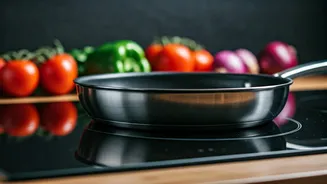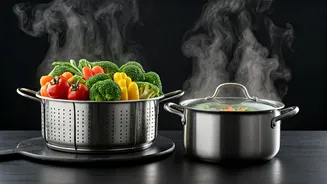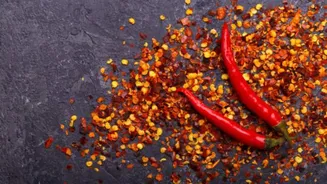Minced Garlic: Overview
Mincing garlic creates tiny pieces, releasing the most intense flavor due to the breakdown of cell walls. This method is ideal when you want garlic to permeate
a dish completely, often used in sauces, marinades, and dressings. The small pieces ensure an even distribution of flavor, making it perfect for dishes where you want garlic to be subtly present throughout. For the best results, use a sharp knife and a rocking motion to chop the garlic cloves finely. Be careful when mincing, as the small pieces can be challenging to manage, and it's easy to accidentally cut your fingers. Make sure your cutting board is stable to prevent accidents. Properly minced garlic ensures that every bite is infused with its powerful flavor, enhancing the overall sensory experience.
Sliced Garlic: Uses
Slicing garlic offers a more delicate flavor than mincing, making it ideal for dishes where you want to taste individual garlic pieces. Sliced garlic provides a visual element, which adds texture and visual appeal to a dish, allowing for a more deliberate garlic presence. This method works well in stir-fries, pasta dishes, and sautéed vegetables. The key to slicing garlic is a steady hand and a sharp knife. Slice the cloves evenly for consistent cooking and flavor distribution. Consider the thickness of your slices; thinner slices cook faster and offer a milder taste. The visual impact of sliced garlic often enhances the plating of dishes, making it an attractive addition to meals. Slicing gives more control over the amount of garlic consumed in each bite.
Diced Garlic: Details
Dicing garlic falls between mincing and slicing in terms of flavor intensity and texture. This method involves chopping the garlic cloves into small, uniform cubes, creating a versatile option for various dishes. Diced garlic provides a noticeable garlic presence without overwhelming other flavors. It works well in sauces, soups, and stews where a slightly chunkier texture is preferred. Achieving a perfect dice requires precise knife skills. Ensure each piece is roughly the same size to cook evenly. Diced garlic offers a balance between flavor and texture, ensuring garlic is present without dominating. This method offers a visually appealing aspect to a dish while providing a pleasant mouthfeel. It is often used in recipes where a balance of texture and flavor is desired.
Chopped Garlic: Overview
Chopping garlic is a simple, quick method that involves roughly cutting the garlic cloves into irregular pieces. This technique is often used when time is limited or when a more rustic texture is desired. The resulting pieces are larger than minced or diced garlic, providing a bolder garlic flavor. Chopped garlic works well in dishes like rustic sauces, hearty soups, and quick stir-fries. The uneven cuts of chopped garlic add to the visual appeal, giving a more informal feel. To chop garlic, remove the peel and roughly cut the cloves. The lack of precision makes it a great choice for fast cooking. Since the garlic pieces are larger, the flavor tends to be more concentrated. Chopping is suitable for dishes where a robust garlic taste is preferred, and appearance is secondary.
Crushed Garlic: Method
Crushing garlic involves using the flat side of a knife blade to break apart the garlic clove. This method releases intense flavors by rupturing the cell walls but leaves the garlic in larger pieces. Crushed garlic is perfect for infusing oils, sauces, and stews. Since the garlic remains relatively intact, it provides a powerful yet not overly distributed flavor. The process is straightforward: place the garlic clove on the cutting board, place the flat side of a knife on top, and press down firmly. Crushed garlic imparts a potent flavor. It's best used when you want a strong garlic presence that can be easily removed before serving, making it great for infusions where the garlic itself isn’t meant to be eaten. Crushing is quick and effective.
Garlic Paste: Purpose
Garlic paste, either store-bought or homemade, offers a convenient way to add garlic flavor to dishes. Made by blending garlic cloves into a smooth consistency, it’s ideal for quickly flavoring sauces, marinades, and dips. Garlic paste provides a uniform distribution of garlic flavor without the need for chopping or mincing. It can be made by blending raw garlic with a small amount of oil, salt, and sometimes water. Using a garlic paste ensures an even dispersion of the flavor throughout a dish. This is particularly useful when cooking for a large group or when you want to simplify meal preparation. Garlic paste saves time and is especially useful in situations where consistent garlic flavor is essential, without visible pieces.
Whole Garlic Cloves: Use
Using whole garlic cloves involves adding unpeeled cloves to dishes, allowing them to infuse flavor without being eaten directly. This method is often used in roasting, braising, or simmering dishes where a subtle garlic flavor is desired. Whole cloves can be roasted alongside vegetables or added to stocks and sauces to infuse flavor without overpowering. The cloves soften and mellow, adding a sweet and savory note to the dish. To use whole cloves, simply add them to your dish. The cloves can be removed before serving, or left in for a more intense flavor. This method is great for dishes where garlic is meant to enhance, not dominate, and can give a richer flavor profile over time.














